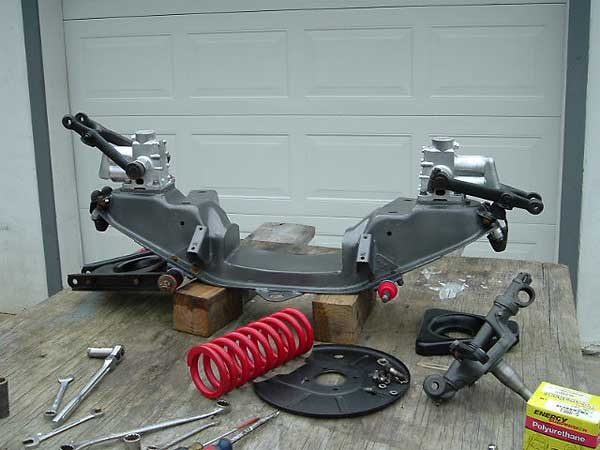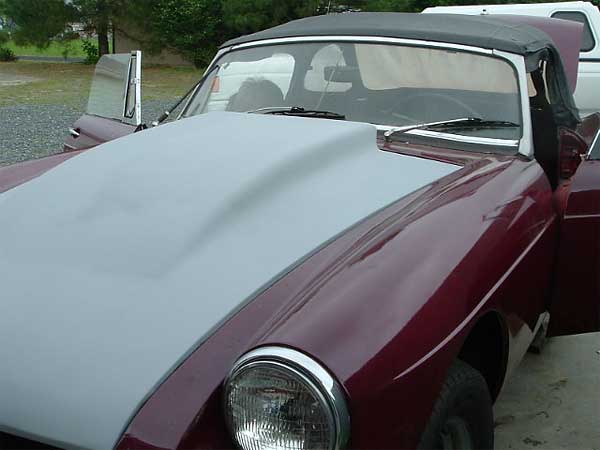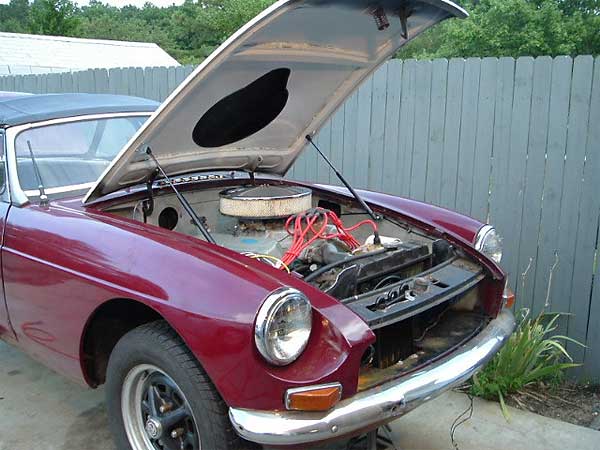
BRITISH LIT. 306: Larry's '64 MGB V8, part 3
as published in British V8 Newsletter, Volume XIII Issue 1, January 2005by: Greg Myer
"The best laid plans of mice and men oft times go astray" A famous quote from... who was that? Mickey Thompson? Carroll Shelby? Hmm, maybe not, it sounds olde British. Aha! Must be Cecil Kimber! It's reassuring when the olde gray matter kicks in and comes up with the answer.
The phrase describes this situation, and my reasoning shows why. Just because something seems logical, doesn't mean it's right. Take wiring, for example. Larry laid plans to come work on his car several times. It didn't work out that way. When he finally got here, what seemed reasonable wasn't right.
Since I'm handling the mechanical end of the swap, Larry was assigned the electrical duties.
It seems his '64 MGB roadster was in dire need of a wiring update. He purchased a complete
harness from Dan Masters in Maryville, Tenn. What he got was a beautiful work of art. The
power board had everything you could possibly need: fuses, relays, flashers, etc. It comes
with more than enough color coded wire to reach the far corners of the car and extra wire
and fittings. It's just a fantastic package. It also comes with an 18 page instruction booklet.
Neither Larry nor I are electrical engineers. That being said, we're not dummies either. We have both done some wiring in our homes and added electrical items to cars and have had no problems. This, however, is a whole lot more! All the wiring in the car had to come out. That's the easy part. Larry chose the passenger side kick panel as the location to hang the power block. Good choice. It's out of harm's way and still accessible. Unfortunately, Larry is 6' 1" tall and doesn't fit down there easily, but he's doing it. The booklet has suggestions for several British sports cars. Reading the ENTIRE booklet takes some time. Do it anyway!

Neither Larry nor I are electrical engineers. That being said, we're not dummies either. We have both done some wiring in our homes and added electrical items to cars and have had no problems. This, however, is a whole lot more! All the wiring in the car had to come out. That's the easy part. Larry chose the passenger side kick panel as the location to hang the power block. Good choice. It's out of harm's way and still accessible. Unfortunately, Larry is 6' 1" tall and doesn't fit down there easily, but he's doing it. The booklet has suggestions for several British sports cars. Reading the ENTIRE booklet takes some time. Do it anyway!

You need to be familiar with the wiring diagrams as well. The instructions are complete,
but you may have some questions. Larry did. Much of the wiring was straightforward, but
switches and relays were the sticking point. Much of the 'olde' MGB equipment has no markings
describing what it does. The ignition switch, for example; three connections, but which one
is for Power, ON, and Accessories? We thought we knew. We didn't. The B&M Quicksilver
shifter has a neutral safety switch in it that needs to be wired too.
When we finally got that squared away and had power to the fuel pump, coil and starter... well, you know what we had to try next. She fired right up and idled smoothly - big grins all around! We don't have the gauges here yet, so I had an old oil pressure gauge in the engine compartment, hooked up so we knew what was going on: 50 PSI at idle cold. It'll drop with heat and besides, the oil we used was a bit on the heavy side for the day's temperature. It sure was great to get the 306 lit in that little Brit.
The home built headers sealed fine. The wrapping and paint smoked as they heated up. The DYNOMAX turbo mufflers controlled the sound nicely too. They are small enough to fit under the car and still do the job. They are throaty, but not loud at idle as they are wrapped internally with fiberglass. Larry didn't want it too loud, as the exhaust exits three and a half feet from your ears when you are sitting in the car with the top down.
There was a bit more smoke than there needed to be though. The oil pressure gauge had its plastic tube wrapped around here and there. "There" being on the wrapped header. That's not enough insulation to keep the plastic from melting. I noticed a loss of pressure first, but Larry saw why. Two sets of eyes when first firing an engine is a good idea. The test session lasted about 15 minutes. Long enough to warm up the engine, look for leaks, etc. Now we really can't wait!
All of this was possible because some other things had been finished up in the meantime. I pulled the front suspension out of the car and rebuilt it. Pulling the crossmember isn't really necessary to do this, but I had cut and welded it to allow the Ford sump to fit, and it needed sanding and painting. Besides, when I primed the oil pump, I didn't get consistent pressure. I use an old distributor, with the cam driven gear removed and the top cut off, turned by a 1/2 inch drill to spin the pump to prime the motor. I was drawing a bit of air into the system from somewhere. With the crossmember off, it was easy to pull the pan. I had brazed the pickup tube to its flange so that it would never move. This caused a slight warp. A few seconds with a flat file and it was good to go.

The suspension itself was another story. It had seen 40 years of use, and more than a few of them had passed without the proper care. One king pin was great but the other was bad. Since I have several parts cars out behind the fence, I rounded up enough good parts to finish the job. It also needed 2 lower A-arms as the bolt holes had become elongated.
Prior to this discovery, Larry had been blaming the wire wheels for the funny feeling in the front end (and they may have been part of the problem, too). Just remember, before you get rid of your wire wheels, rebuild the suspension first. In our case, since the wires wouldn't take the torque of the Ford, we had already upgraded to steel wheels. Who knows, maybe aluminum wheels are in the near future.
I used polyurethane bushings during the rebuild as the will help the suspension do its job more precisely, and have the added benefit of lasting longer. The coil springs? Well we made some calculations and still weren't exactly sure what was needed. The originals sagged badly and would never hold the weight of the Ford. Just then, however, Barrie Robinson in Canada advertised on the MGB-V8 e-mail list (mgb-v8@autox.team.net) that he had a pair of springs that were too strong for his aluminum V8 project. He listed the part # and in checking, they looked like a good place to start. (If you're not on the list, you're missing a lot.) New Zerk fittings were installed where needed so everything could be lubed properly. Then everything was painted and reassembled.
Since the car is a chrome-bumper model and sits low to start with, I installed 3/8 inch steel shims between the frame and crossmember. This uses all the length of the bolts, but gives us that little extra height. The rack still had to be angled down some more as the shaft was too close to the rear spark plug. All of that is back together, but the column isn't quite finished.
When we finally got that squared away and had power to the fuel pump, coil and starter... well, you know what we had to try next. She fired right up and idled smoothly - big grins all around! We don't have the gauges here yet, so I had an old oil pressure gauge in the engine compartment, hooked up so we knew what was going on: 50 PSI at idle cold. It'll drop with heat and besides, the oil we used was a bit on the heavy side for the day's temperature. It sure was great to get the 306 lit in that little Brit.
|
Enjoying this article? Our magazine is funded through the generous support of readers like you! To contribute to our operating budget, please click here and follow the instructions. (Suggested contribution is twenty bucks per year. Feel free to give more!) |
The home built headers sealed fine. The wrapping and paint smoked as they heated up. The DYNOMAX turbo mufflers controlled the sound nicely too. They are small enough to fit under the car and still do the job. They are throaty, but not loud at idle as they are wrapped internally with fiberglass. Larry didn't want it too loud, as the exhaust exits three and a half feet from your ears when you are sitting in the car with the top down.
There was a bit more smoke than there needed to be though. The oil pressure gauge had its plastic tube wrapped around here and there. "There" being on the wrapped header. That's not enough insulation to keep the plastic from melting. I noticed a loss of pressure first, but Larry saw why. Two sets of eyes when first firing an engine is a good idea. The test session lasted about 15 minutes. Long enough to warm up the engine, look for leaks, etc. Now we really can't wait!
All of this was possible because some other things had been finished up in the meantime. I pulled the front suspension out of the car and rebuilt it. Pulling the crossmember isn't really necessary to do this, but I had cut and welded it to allow the Ford sump to fit, and it needed sanding and painting. Besides, when I primed the oil pump, I didn't get consistent pressure. I use an old distributor, with the cam driven gear removed and the top cut off, turned by a 1/2 inch drill to spin the pump to prime the motor. I was drawing a bit of air into the system from somewhere. With the crossmember off, it was easy to pull the pan. I had brazed the pickup tube to its flange so that it would never move. This caused a slight warp. A few seconds with a flat file and it was good to go.

The suspension itself was another story. It had seen 40 years of use, and more than a few of them had passed without the proper care. One king pin was great but the other was bad. Since I have several parts cars out behind the fence, I rounded up enough good parts to finish the job. It also needed 2 lower A-arms as the bolt holes had become elongated.
Prior to this discovery, Larry had been blaming the wire wheels for the funny feeling in the front end (and they may have been part of the problem, too). Just remember, before you get rid of your wire wheels, rebuild the suspension first. In our case, since the wires wouldn't take the torque of the Ford, we had already upgraded to steel wheels. Who knows, maybe aluminum wheels are in the near future.
I used polyurethane bushings during the rebuild as the will help the suspension do its job more precisely, and have the added benefit of lasting longer. The coil springs? Well we made some calculations and still weren't exactly sure what was needed. The originals sagged badly and would never hold the weight of the Ford. Just then, however, Barrie Robinson in Canada advertised on the MGB-V8 e-mail list (mgb-v8@autox.team.net) that he had a pair of springs that were too strong for his aluminum V8 project. He listed the part # and in checking, they looked like a good place to start. (If you're not on the list, you're missing a lot.) New Zerk fittings were installed where needed so everything could be lubed properly. Then everything was painted and reassembled.
Since the car is a chrome-bumper model and sits low to start with, I installed 3/8 inch steel shims between the frame and crossmember. This uses all the length of the bolts, but gives us that little extra height. The rack still had to be angled down some more as the shaft was too close to the rear spark plug. All of that is back together, but the column isn't quite finished.
Having the front back in was a good feeling. Wanting to start the engine was working on
me now. We needed fuel to the carburetor next. The gas tank was rusty and had holes in it.
Not good. We thought of using a fuel cell. After searching high and low, we couldn't come
up with one that would hold as much as the stock tank, without having to cut something to
make it fit. A new replacement tank was ordered and it worked perfectly! The new fuel pump
was hung and new steel lines run to the front. With power to the pump, gas filled the
carburetor and overflowed. What? The carb had just been rebuilt and the lines were new.
I pulled the top off the Edelbrock 750 to find one needle off its seat. Just a small piece
of gunk, and I have no idea where it came from. After that everything was fine.

One other item of note: the hood. The air filter wouldn't fit. Not even close! So a scoop was obtained from Unlimited Products. It was determined that we needed one with a curve in it. They have several. The ones for the Chevy S-10 seemed to fit the bill. We ordered # SC-404, which is 43 inches long, 24 wide, 2 3/4 high with an inch and 5/8 curve. That curve was a bit much. It fit perfectly at the front of the hood, but not where we needed it. (# SC-402 might be a better fit) It was modified slightly and bonded, and then molded in. A hole was cut in the hood for clearance first.

Around the edges of the hole I used NAPA car door molding. It's quite flexible and cleans up the sheetmetal edges nicely. It also protects the plug's wires from abrasion as they come up rather high. Ian Pender's gas hood struts were installed and lift the hood in a fine fashion. So that about wraps it up for another issue. The engine lit right up and there was dancing in the driveway, but the wiring proved more difficult than expected and a return trip with an ohm-meter is needed. "It was the best of times, it was the worst of times." Hey, that's another British quote. Let's see....who said that? Ken Costello? Syd Enever? I don't know, beats the Dickens out of me!
Disclaimer: This page was researched and written by Greg Myer. Views expressed are those of the author, and are provided without warrantee or guarantee. Apply at your own risk.

One other item of note: the hood. The air filter wouldn't fit. Not even close! So a scoop was obtained from Unlimited Products. It was determined that we needed one with a curve in it. They have several. The ones for the Chevy S-10 seemed to fit the bill. We ordered # SC-404, which is 43 inches long, 24 wide, 2 3/4 high with an inch and 5/8 curve. That curve was a bit much. It fit perfectly at the front of the hood, but not where we needed it. (# SC-402 might be a better fit) It was modified slightly and bonded, and then molded in. A hole was cut in the hood for clearance first.

Around the edges of the hole I used NAPA car door molding. It's quite flexible and cleans up the sheetmetal edges nicely. It also protects the plug's wires from abrasion as they come up rather high. Ian Pender's gas hood struts were installed and lift the hood in a fine fashion. So that about wraps it up for another issue. The engine lit right up and there was dancing in the driveway, but the wiring proved more difficult than expected and a return trip with an ohm-meter is needed. "It was the best of times, it was the worst of times." Hey, that's another British quote. Let's see....who said that? Ken Costello? Syd Enever? I don't know, beats the Dickens out of me!
Disclaimer: This page was researched and written by Greg Myer. Views expressed are those of the author, and are provided without warrantee or guarantee. Apply at your own risk.

